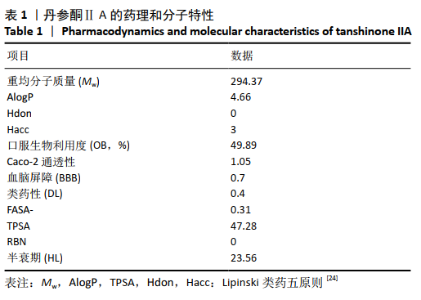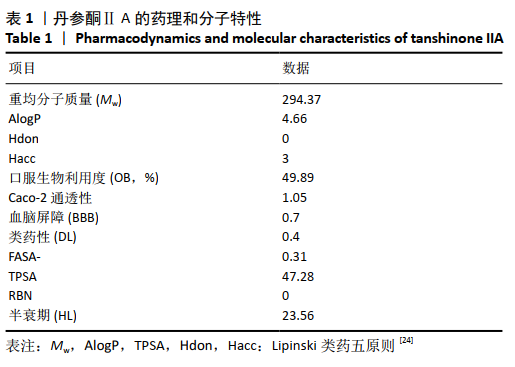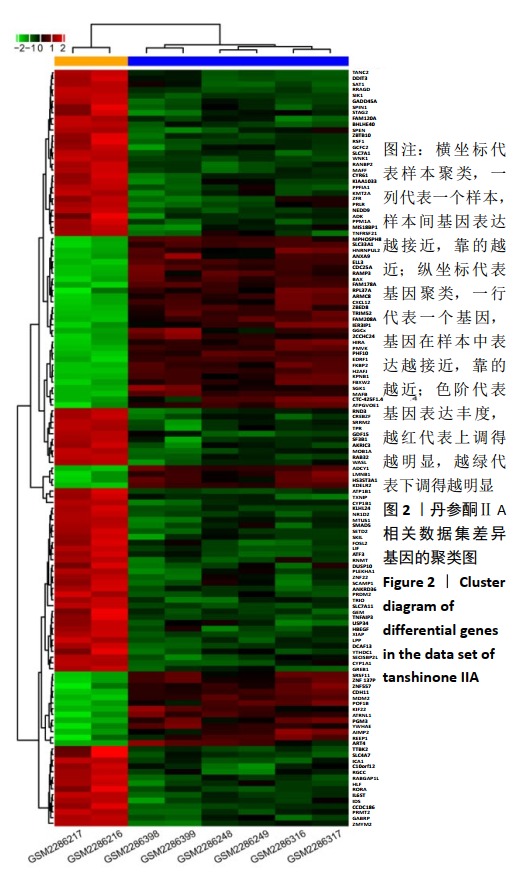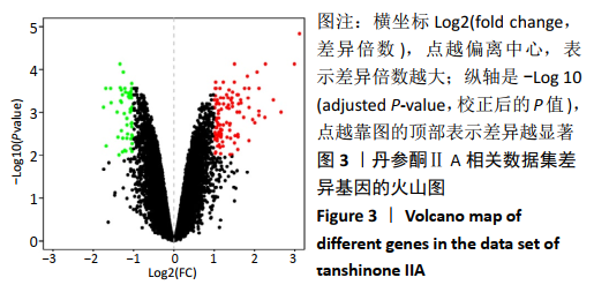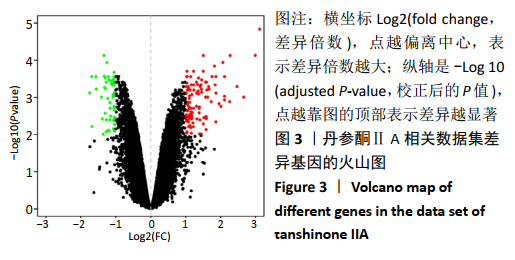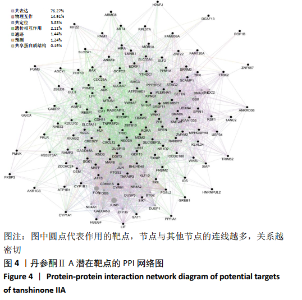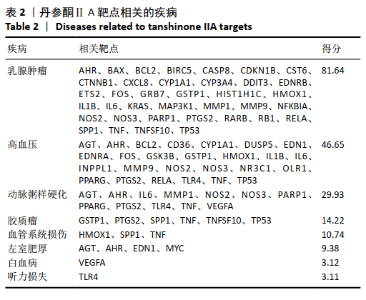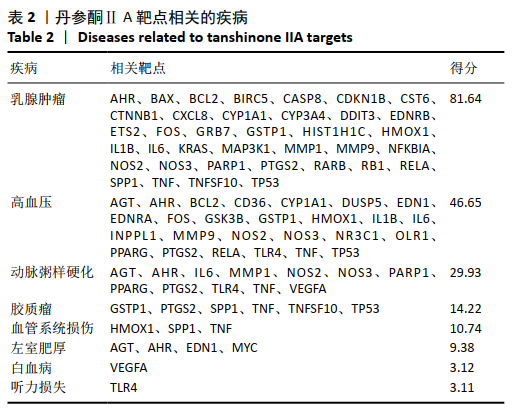Chinese Journal of Tissue Engineering Research ›› 2021, Vol. 25 ›› Issue (35): 5656-5661.doi: 10.12307/2021.296
Previous Articles Next Articles
Tanshinone IIA treats vascular system injury: possible molecular mechanism and biological processes
Wen Mingtao1, Xu Bo1, Li Jiacheng1, Liu Jinbao1, Li Gang2
- 1Shandong University of Traditional Chinese Medicine, Jinan 250355, Shandong Province, China; 2Department of Orthopedics, Affiliated Hospital of Shandong University of Traditional Chinese Medicine, Jinan 250014, Shandong Province, China
-
Received:2020-11-30Revised:2020-12-05Accepted:2021-01-16Online:2021-12-18Published:2021-08-05 -
Contact:Li Gang, MD, Professor, Doctoral supervisor, Department of Orthopedics, Affiliated Hospital of Shandong University of Traditional Chinese Medicine, Jinan 250014, Shandong Province, China -
About author:Wen Mingtao, Master candidate, Shandong University of Traditional Chinese Medicine, Jinan 250355, Shandong Province, China -
Supported by:the National Natural Science Foundation of China, No. 81774333 and 81373660 (both to LG)
CLC Number:
Cite this article
Wen Mingtao, Xu Bo, Li Jiacheng, Liu Jinbao, Li Gang. Tanshinone IIA treats vascular system injury: possible molecular mechanism and biological processes[J]. Chinese Journal of Tissue Engineering Research, 2021, 25(35): 5656-5661.
share this article
Add to citation manager EndNote|Reference Manager|ProCite|BibTeX|RefWorks
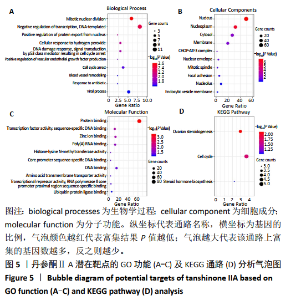
2.4 DAVID富集分析结果 为了进一步分类丹参酮IIA潜在靶点的生物学功能,通过DAVID 6.8进行GO和Pathway通路富集分析。分析结果显示,潜在靶点的生物学过程(biological processes,BP)主要在核分裂、DNA模板转录负调控、细胞核蛋白质输出的正调控、对过氧化氢的细胞反应及P53类介导的DNA损伤反应及信号转导导致细胞周期阻滞等过程中明显富集,见图5A;细胞成分(cellular component,CC)的变化主要集中在细胞核、核浆、细胞溶质、薄膜及CHOP-ATF3配合物等,见图5B;分子功能(molecular function,MF)的变化主要表现在蛋白质结合、转录因子活性,序列特异性DNA结合、锌离子结合、聚(A)RNA结合、组蛋白-赖氨酸N-甲基转移酶活性等,见图5C。KEGG通路分析表明潜在靶点主要在卵巢类固醇生成、细胞周期及类固醇激素生物合成中富集,见图5D。"
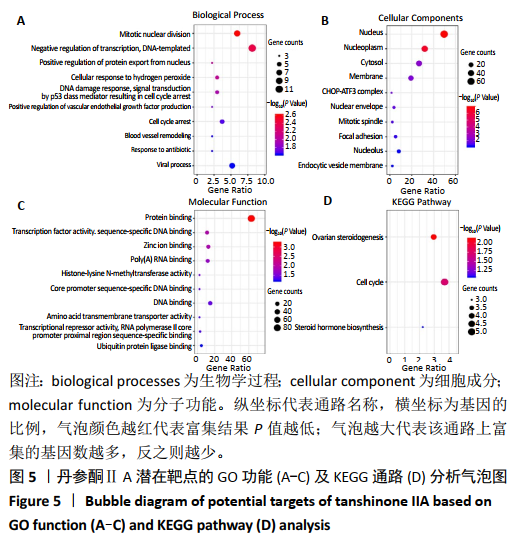
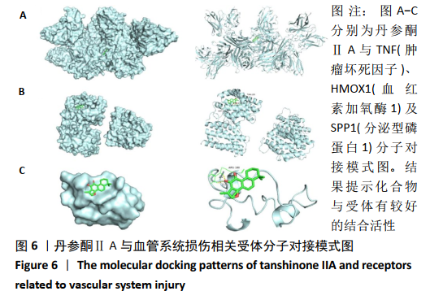
2.6 分子对接结果 血管系统损伤关键靶点主要包括血红素加氧酶1(HMOX1)、分泌型磷蛋白1(SPP1)、肿瘤坏死因子(TNF)。分子对接方法通过匹配原则算法计算结合能模拟蛋白质与小分子受体互作。若配体与受体结合能量越低,则结合构象越稳定,相互作用的可能性越大。研究表明,结合能量< -20.9 kJ/mol,受体与配体的结合效果较强。此次研究分子对接结果验证表明,丹参酮ⅡA与肿瘤坏死因子(TNF, -38.51 kJ/mol)、血红素加氧酶1(HMOX1,-37.67 kJ/mol)、分泌型磷蛋白1(SPP1,-28.04 kJ/mol)结合能量均 < -20.93 kJ/mol,提示化合物与受体有较好的结合活性。丹参酮ⅡA与血管系统损伤相关受体分子对接模式见图6。"
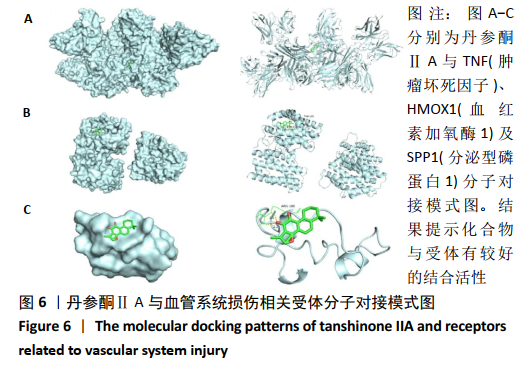
| [1] 康渊强,高明宇.丹参治疗冠心病的现状及其机制研究进展 [J]. 辽宁医学杂志,2019,33(2):85-88. [2] 徐文华,郑景辉,赵阳,等.基于网络药理学和生物信息学的丹参酮Ⅱ_A治疗冠心病的分子生物学机制分析[J]. 中草药,2019,50(5): 1131-1140. [3] 苏梅,秦引林,娄雅静,等.丹参酮Ⅱ_A磺酸钠体内外促血管新生作用的研究[J]. 现代药物与临床,2019,34(4):934-940. [4] 宁剑,何春玲,黄健军.丹参酮ⅡA体内外抗炎作用研究[J]. 现代药物与临床,2019,34(2):292-298. [5] 田清山.丹参酮IIA辅助治疗慢性心力衰竭的meta分析[D].南昌:南昌大学,2018. [6] YANG YD, YU X, WANG XM, et al. Tanshinone IIA improves functional recovery in spinal cord injury-induced lower urinary tract dysfunction. Neural Regen Res. 2017;12(2):267-275. [7] 洪郭驹,何伟,魏秋实,等. 血管生长细胞因子与股骨头坏死(英文) [J]. 中国组织工程研究,2016,20(15):2197-2205. [8] 胡敏,范建楠,赵宏斌,等. 激素性股骨头坏死模型兔血管内皮细胞生长因子表达与普伐他汀的干预[J]. 中国组织工程研究与临床康复,2011,15(15):2703-2706. [9] 胡志明,王海彬,李祖国,等.血管内皮细胞生长因子促进激素性股骨头坏死修复[J]. 中国矫形外科杂志,2006,14(15):1179-1181. [10] 吴云刚,肖鲁伟,童培建,等.介入治疗激素性股骨头坏死血管内皮细胞生长因子表达的实验研究[J]. 中国矫形外科杂志,2002, 10(11):1094-1096. [11] MONT MA, SALEM HS, PIUZZI NS, et al. Nontraumatic Osteonecrosis of the Femoral Head: Where Do We Stand Today?: A 5-Year Update. J Bone Joint Surg Am. 2020;102(12):1084-1099. [12] WANG A, REN M, WANG J. The pathogenesis of steroid-induced osteonecrosis of the femoral head: A systematic review of the literature. Gene. 2018;671:103-109. [13] 中国成人股骨头坏死临床诊疗指南(2020) [J]. 中华骨科杂志,2020, 40(20):1365-1376. [14] 李时斌,赖渝,周毅,等. 激素性股骨头坏死发病机制及相关信号通路的靶点效应 [J]. 中国组织工程研究,2020,25(6):935-941. [15] RU J, LI P, WANG J, et al. TCMSP: a database of systems pharmacology for drug discovery from herbal medicines. J Cheminform. 2014;6:13. [16] XU X, ZHANG W, HUANG C, et al. A Novel Chemometric Method for the Prediction of Human Oral Bioavailability. Int J Mol Sci. 2012;13(6): 6964-6982. [17] TAO W, XU X, WANG X, et al. Network pharmacology-based prediction of the active ingredients and potential targets of Chinese herbal Radix Curcumae formula for application to cardiovascular disease.J Ethnopharmacol. 2013;145(1):1-10. [18] YANG H, ZHANG W, HUANG C, et al. A novel systems pharmacology model for herbal medicine injection: a case using reduning injection. BMC Complement Altern Med. 2014;14:430. [19] Tattersall MH, Sodergren JE, Dengupta SK, et al. Pharmacokinetics of actinoymcin D in patients with malignant melanoma. Clin Pharmacol Ther. 1975;17(6):701-708. [20] DIRK W, RENE H, PETER K, et al. Identification of rheumatoid arthritis and osteoarthritis patients by transcriptome-based rule set generation. Arthritis Res Ther. 2014;16(2):R84. [21] MOSTAFAVI S, RAY D, WARDE-FARLEY D, et al. GeneMANIA: a real-time multiple association network integration algorithm for predicting gene function. Genome Biol. 2008;9 Suppl 1(Suppl 1):S4. [22] HUANG DA W, SHERMAN BT, LEMPICKI RA. Systematic and integrative analysis of large gene lists using DAVID bioinformatics resources. Nat Protoc. 2009;4(1):44-57. [23] DAVIS AP, GRONDIN CJ, JOHNSON RJ, et al. The Comparative Toxicogenomics Database: update 2019. Nucleic Acids Res. 2019; 47(D1):D948-D954. [24] LIPINSKI CA, LOMBARDO F, DOMINY BW, et al. Experimental and computational approaches to estimate solubility and permeability in drug discovery and development settings. Adv Drug Deliv Rev. 2001; 46(1-3):3-26. [25] VAN DE WATERBEEMD H, GIFFORD E. ADMET in silico modelling: towards prediction paradise?. Nat Rev Drug Discov. 2003;2(3):192-204. [26] 张媛,毛浩萍,樊官伟.丹参酮ⅡA药理作用研究进展[J]. 天津中医药大学学报,2019,38(1):15-19. [27] 侯文书,张力.丹参酮ⅡA对心血管系统的药理作用及其新剂型研究进展[J]. 中国药理学与毒理学杂志,2017,31(5):484. [28] 陈芬燕,郭韧,张毕奎.丹参酮Ⅱ_A的心血管药理作用研究进展 [J]. 中国中药杂志,2015,40(9):1649-53. [29] ZHANG X, MA Z, LIANG Q, et al. Tanshinone IIA exerts protective effects in a LCA-induced cholestatic liver model associated with participation of pregnane X receptor. J Ethnopharmacol. 2015;164:357-367. [30] JING L, WEIJIANG S, GUOYAN Y, et al. Compound Danshen (Salvia miltiorrhiza) dripping pill for coronary heart disease: an overview of systematic reviews. Am J Chin Med. 2015;43(1):25-43. [31] WING-SHING CHEUNG D, KOON CM, NG CF, et al. The roots of Salvia miltiorrhiza (Danshen) and Pueraria lobata (Gegen) inhibit atherogenic events: A study of the combination effects of the 2-herb formula.J Ethnopharmacol. 2012;143(3):859-866. [32] XU W, YANG J, WU LM. Cardioprotective effects of tanshinone IIA on myocardial ischemia injury in rats. Pharmazie. 2009;64(5):332-336. [33] 周丽,刘艳平,王芳,等.丹参酮Ⅱ_A对I/R大鼠脑组织NF-κB和IκB活性的影响[J].中药材,2013,36(7):1136-1139. [34] 王炎,刘宣,周利红,等.丹参酮Ⅱ_A对裸鼠人肠癌血管新生的抑制作用[J].中国实验方剂学杂志,2013,19(3):167-171. [35] NAKAHARA H, SONG J, SUGIMOTO M, et al. Anti–interleukin‐6 receptor antibody therapy reduces vascular endothelial growth factor production in rheumatoid arthritis. Arthritis Rheum. 2003;48(6): 1521-1529. [36] BALAJI S, LESAINT M, BHATTACHARYA SS, et al. Adenoviral-mediated gene transfer of insulin-like growth factor 1 enhances wound healing and induces angiogenesis. J Surg Res. 2014;190(1):367-377. [37] HATANPAA KJ, BURMA S, ZHAO D, et al. Epidermal Growth Factor Receptor in Glioma: Signal Transduction, Neuropathology, Imaging, and Radioresistance. Neoplasia. 2010;12(9):675-684. [38] 胡亮,王军海,王志烈,等.血管内皮生长因子联合突变型低氧诱导因子1α的促血管生成作用[J]. 中国组织工程研究,2019,23(3): 378-383. [39] 吴涛,孙瑞敏,王慧利,等. 经股动脉灌注成纤维细胞生长因子对兔股骨头缺血性坏死新生血管及骨密度的影响 [J].中国临床药理学杂志,2020,36(17):2658-2560. [40] WAZA AA, HAMID Z, ALI S, et al. A review on heme oxygenase-1 induction: is it a necessary evil. Inflamm Res. 2018;67(7):579-588. [41] ICER MA, GEZMEN-KARADAG M. The multiple functions and mechanisms of osteopontin. Clin Biochem. 2018;59:17-24. |
| [1] | An Yang, Liao Yinan, Xie Chengxin, Li Qinglong, Huang Ge, Jin Xin, Yin Dong. Mechanism of Inulae flos in the treatment of osteoporosis: an analysis based on network pharmacology [J]. Chinese Journal of Tissue Engineering Research, 2021, 25(在线): 1-8. |
| [2] | Li Jiacheng, Liang Xuezhen, Liu Jinbao, Xu Bo, Li Gang. Differential mRNA expression profile and competitive endogenous RNA regulatory network in osteoarthritis [J]. Chinese Journal of Tissue Engineering Research, 2021, 25(8): 1212-1217. |
| [3] | Geng Qiudong, Ge Haiya, Wang Heming, Li Nan. Role and mechanism of Guilu Erxianjiao in treatment of osteoarthritis based on network pharmacology [J]. Chinese Journal of Tissue Engineering Research, 2021, 25(8): 1229-1236. |
| [4] | Li Yonghua, Feng Qiang, Tan Renting, Huang Shifu, Qiu Jinlong, Yin Heng. Molecular mechanism of Eucommia ulmoides active ingredients treating synovitis of knee osteoarthritis: an analysis based on network pharmacology [J]. Chinese Journal of Tissue Engineering Research, 2021, 25(5): 765-771. |
| [5] | Song Shan, Hu Fangyuan, Qiao Jun, Wang Jia, Zhang Shengxiao, Li Xiaofeng. An insight into biomarkers of osteoarthritis synovium based on bioinformatics [J]. Chinese Journal of Tissue Engineering Research, 2021, 25(5): 785-790. |
| [6] | An Yang, Liao Yinan, Xie Chengxin, Li Qinglong, Huang Ge, Jin Xin, Yin Dong. Mechanism of Inulae flos in the treatment of osteoporosis: an analysis based on network pharmacology [J]. Chinese Journal of Tissue Engineering Research, 2021, 25(35): 5662-5669. |
| [7] | Zou Kun, Guo Wanshou, Deng Yawen, Zhang Qidong, Liu Pei, Wang Weiguo. Molecular mechanism of curcumin in the treatment of knee osteoarthritis based on bioinformatics and network pharmacology [J]. Chinese Journal of Tissue Engineering Research, 2021, 25(32): 5132-5140. |
| [8] | Lin Ruohui, Chen Sainan, Ye Yunjin, Chen Juan, Xie Lihua, Huang Jingwen, Ge Jirong, Li Shengqiang. Protective mechanism of Gushukang granule in a rat osteoporosis model based on TMT proteomic analysis [J]. Chinese Journal of Tissue Engineering Research, 2021, 25(32): 5141-5147. |
| [9] | Huang Hui, Zheng Jiaxuan, Fang Yehan, Wang Guangji. Bioinformatics analysis of degenerative meniscus in knee osteoarthritis [J]. Chinese Journal of Tissue Engineering Research, 2021, 25(29): 4664-4671. |
| [10] | Rong Weiming, Yuan Changshen, Duan Kan, Lu Zhixian, Mei Qijie, Guo Jinrong. Molecular mechanism of osteoarthritis by multi-chip combination analysis [J]. Chinese Journal of Tissue Engineering Research, 2021, 25(26): 4223-4229. |
| [11] | Chen Feng, Zhang Xiaoyun, Chen Yueping, Liao Jianzhao, Li Jiajun, Song Shilei, Lai Yu. Molecular mechanism of anhydroicaritin in the treatment of osteoarthritis: an analysis based on network pharmacology and bioinformatics [J]. Chinese Journal of Tissue Engineering Research, 2021, 25(23): 3704-3710. |
| [12] | Zhang Haitao, Chen Jinlun, Zhu Xingyang, Zeng Huiliang, Li Jie, Sun Xiaobo, Qi Xinyu, Zeng Jianchun, Zeng Yirong. Effect and molecular mechanism of Honeysuckle-Rhizoma coptidis in the treatment of periprosthetic joint infection based on molecular docking and network pharmacology [J]. Chinese Journal of Tissue Engineering Research, 2021, 25(21): 3360-3367. |
| [13] | Zhong Yuanming, He Bingkun, Wu Zhuotan, Wu Sixian, Wan Tong, Zhong Xifeng. An exploration on the mechanism of Shaoyao Gancao Decoction in treating early pain of lumbar disc herniation based on network pharmacology [J]. Chinese Journal of Tissue Engineering Research, 2021, 25(20): 3194-3201. |
| [14] | Yuan Changshen, Rong Weiming, Lu Zhixian, Duan Kan, Guo Jinrong, Mei Qijie. Construction of osteosarcoma miRNA-mRNA regulatory network based on bioinformatics [J]. Chinese Journal of Tissue Engineering Research, 2021, 25(17): 2740-2746. |
| [15] | Shen Fu, Kuang Gaoyan, Yang Zhuo, Wen Meng, Zhu Kaimin, Yu Guizhi, Xu Wuji, Deng Bo . Immune infiltration mechanism of differential expression genes in rheumatoid arthritis and potential therapeutic prediction of Chinese herbs [J]. Chinese Journal of Tissue Engineering Research, 2021, 25(14): 2183-2191. |
| Viewed | ||||||
|
Full text |
|
|||||
|
Abstract |
|
|||||
